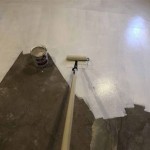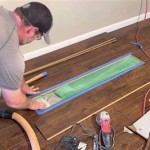Essential Aspects of Installing Vinyl Plank Flooring on Uneven Concrete
Installing vinyl plank flooring on uneven concrete might seem like a daunting task. But with the right preparation and techniques, you can achieve a seamless and professional-looking installation. Here are some essential aspects to consider when tackling this project:
1. Preparing the Subfloor:
The key to a successful vinyl plank flooring installation lies in preparing the subfloor. Uneven concrete can create bumps and imperfections that can affect the flooring's stability and appearance. To address this, you need to level the concrete surface using self-leveling compound or a concrete grinder.
2. Choose the Right Underlayment:
An underlayment is a crucial component that provides additional cushioning and support for the vinyl plank flooring. For uneven concrete, a thicker underlayment (6mm or more) is recommended. It will absorb irregularities, reduce noise, and improve the overall comfort of the flooring.
3. Stagger the Planks:
Staggering the planks is essential to distribute the weight evenly and prevent the floor from buckling or warping over time. When installing the first row, cut the first and last planks to a random length to create a staggered pattern. Continue this pattern throughout the installation to ensure a natural and realistic look.
4. Use a Spacer:
To maintain a consistent gap between the planks, use spacers. These spacers will prevent the planks from shifting and ensure a tight fit. Remove the spacers after the planks are locked into place.
5. Trim the Planks:
As you reach walls, doorways, or obstacles, you will need to trim the vinyl planks accordingly. Use a sharp utility knife or a flooring cutter to make precise cuts. Measuring twice and cutting once is crucial to ensure a clean and professional finish.
6. Secure the Perimeter:
Once the vinyl planks are installed, secure the perimeter using molding or quarter round. This will prevent the planks from moving or lifting, adding a finished touch to your flooring.
7. Allow for Acclimation:
Before installing the vinyl plank flooring, allow it to acclimate to the room temperature for at least 48 hours. This will stabilize the planks and prevent potential buckling or warping due to temperature fluctuations.
Installing vinyl plank flooring on uneven concrete can be a rewarding DIY project with proper preparation and attention to detail. By following these essential aspects, you can achieve a durable and aesthetically pleasing floor that will enhance the look and feel of your space.

Vinyl Plank Flooring On Uneven Concrete

Vinyl Plank Flooring On Uneven Concrete

10 Beginner Mistakes Installing Vinyl Plank Flooring

Vinyl Plank Flooring On Uneven Concrete

Should We Be Concerned About Vinyl Plank Installed Over Uneven Floors

Vinyl Plank Flooring On Uneven Concrete

How Can I Prepare Uneven Concrete Basement Floor For Vinyl Planks Home Improvement Stack Exchange

Easy Ways To Install Vinyl Plank Flooring On Concrete

How Can I Prepare Uneven Concrete Basement Floor For Vinyl Planks Home Improvement Stack Exchange

Flooring Is This Small Slope A Problem Installing Vinyl Plank Home Improvement Stack Exchange
See Also







